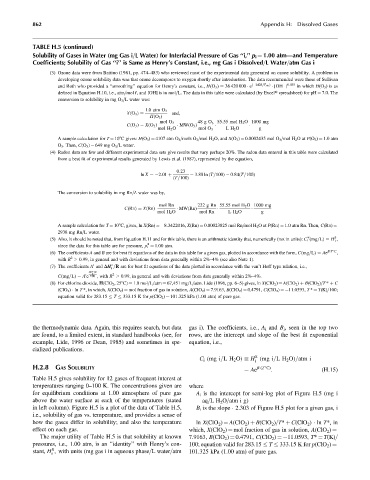Page 907 - Fundamentals of Water Treatment Unit Processes : Physical, Chemical, and Biological
P. 907
862 Appendix H: Dissolved Gases
TABLE H.5 (continued)
Solubility of Gases in Water (mg Gas i=L Water) for Interfacial Pressure of Gas ‘‘i,’’ p i ¼ 1.00 atm—and Temperature
Coefficients; Solubility of Gas ‘‘i’’ is Same as Henry’s Constant, i.e., mg Gas i Dissolved=L Water=atm Gas i
(3) Ozone data were from Battino (1981, pp. 474–483) who reviewed most of the experimental data generated on ozone solubility. A problem in
developing ozone solubility data was that ozone decomposes to oxygen shortly after introduction. The data recommended were those of Sullivan
0:035
and Roth who provided a ‘‘smoothing’’ equation for Henry’s constant, i.e., H(O 3 ) ¼ 38 420 000 e ( 2428=T abs ) [OH ] in which H(O 3 )isas
defined in Equation H.10, i.e., atm=mol f, and [OH] is in mol=L. The data in this table were calculated (by Excelt spreadsheet) for pH ¼ 7.0. The
conversion to solubility in mg O 3 =L water was:
1:0 atm O 3
and,
H(O 3 )
X(O 3 ) ¼
48 gO 3 55:55 mol H 2 O 1000 mg
mol O 3
C(O 3 ) ¼ X(O 3 ) MW(O 3 )
mol H 2 O mol O 3 LH 2 O g
A sample calculation for T ¼ 108C gives: H(O 3 ) ¼ 4107 atm O 3 =mols O 3 =mol H 2 O, and X(O 3 ) ¼ 0.0002435 mol O 3 =mol H 2 Oat P(O 3 ) ¼ 1.0 atm
O 3 . Then, C(O 3 ) ¼ 649 mg O 3 =L water.
(4) Radon data are few and different experimental data sets give results that vary perhaps 20%. The radon data entered in this table were calculated
from a best fit of experimental results generated by Lewis et al. (1987), represented by the equation,
0:23
3:88 ln (T=100) 0:84(T=100)
(T=100)
ln X ¼ 2:01 þ
The conversion to solubility in mg Rn=L water was by,
mol Rn 222 gRn 55:55 mol H 2 O 1000 mg
C(Rn) ¼ X(Rn) MW(Rn)
mol H 2 O mol Rn LH 2 O g
A sample calculation for T ¼ 108C, gives, ln X(Rn) ¼ 8.3422016, X(Rn) ¼ 0.00023825 mol Rn=mol H 2 Oat P(Rn) ¼ 1.0 atm Rn. Then, C(Rn) ¼
2938 mg Rn=L water.
*
S
(5) Also, it should be noted that, from Equation H.11 and for this table, there is an arithmetic identity that, numerically (not in units): C i (mg=L) ¼ H ,
1
*
since the data for this table are for pressure, p i ¼ 1.00 atm.
(6) The coefficients A and B are for best fit equations of the data in this table for a given gas, plotted in accordance with the form, C(mg=L) ¼ Ae B T C ,
2
with R 0.99, in general and with deviations from data generally within 2%–4% (see also Note 1).
(7) The coefficients A and DH =R are for best fit equations of the data plotted in accordance with the van’t Hoff type relation, i.e.,
0
i
DH =R
2
C(mg=L) ¼ A e T(K) , with R 0.99, in general and with deviations from data generally within 2%–4%.
i
0
(8) For chlorine dioxide, H(ClO 2 ,258C) ¼ 1.0 mol=L=atm ¼ 67,451 mg=L=atm. Lide (1996, pp. 6–5) gives, ln X(ClO 2 ) ¼ A(ClO 2 ) þ B(ClO 2 )=T * þ C
(ClO 2 ) ln T *, in which, X(ClO 2 ) ¼ mol fraction of gas in solution, A(ClO 2 ) ¼ 7.9163, B(ClO 2 ) ¼ 0.4791, C(ClO 2 ) ¼ 11.0593, T * ¼ T(K)=100;
equation valid for 283.15 T 333.15 K for p(ClO 2 ) ¼ 101.325 kPa (1.00 atm) of pure gas.
the thermodynamic data. Again, this requires search, but data gas i). The coefficients, i.e., A i and B i , seen in the top two
are found, to a limited extent, in standard handbooks (see, for rows, are the intercept and slope of the best fit exponential
example, Lide, 1996 or Dean, 1985) and sometimes in spe- equation, i.e.,
cialized publications.
S
C i (mg i=LH 2 O) H (mg i=LH 2 O)=atm i
i
H.2.8 GAS SOLUBILITY B (T C)
¼ Ae : (H:15)
Table H.5 gives solubility for 12 gases of frequent interest at
temperatures ranging 0–100 K. The concentrations given are where
for equilibrium conditions at 1.00 atmosphere of pure gas A i is the intercept for semi-log plot of Figure H.5 (mg i
above the water surface at each of the temperatures (stated aq=LH 2 O=atm i g)
in left column). Figure H.5 is a plot of the data of Table H.5, B i is the slope 2.303 of Figure H.5 plot for a given gas, i
i.e., solubility of gas vs. temperature, and provides a sense of
how the gases differ in solubility; and also the temperature ln X(ClO 2 ) ¼ A(ClO 2 ) þ B(ClO 2 )=T* þ C(ClO 2 ) ln T*, in
effect on each gas. which, X(ClO 2 ) ¼ mol fraction of gas in solution, A(ClO 2 ) ¼
The major utility of Table H.5 is that solubility at known 7.9163, B(ClO 2 ) ¼ 0.4791, C(ClO 2 ) ¼ 11.0593, T* ¼ T(K)=
pressures, i.e., 1.00 atm, is an ‘‘identity’’ with Henry’s con-
100; equation valid for 283.15 T 333.15 K for p(ClO 2 ) ¼
S
stant, H , with units (mg gas i in aqueous phase=L water=atm 101.325 kPa (1.00 atm) of pure gas.
i

